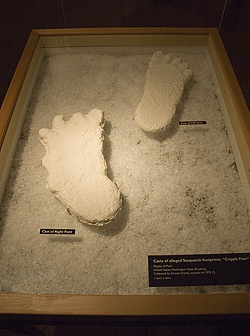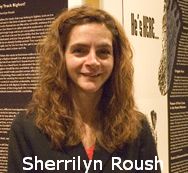Bigfootencounters.com
Bigfoot casts a philosophical shadow
On the heels of Darwin Day, the Hearst Museum displays plaster casts
of alleged Sasquatch footprints - and ponders the nature of evidence and truth
2008 -- Hold your fire, if not your skepticism. In the equivocal spirit of sightings of Bigfoot himself - according to folklore and a handful of so-called cryptozoologists, a towering, humanlike hominid that roams the dense forests of the American Northwest and British Columbia on two legs - casts of what may or may not be the creature's footprints are now on view at the Hearst Museum of Anthropology.
Whatever they are or aren't, though, they are most definitely a conversation piece. The plaster casts were created by the late anthropologist Grover Krantz, a one-time Berkeley grad student and Hearst Museum preparator who went on to become one of the world's best-known researchers of Bigfoot, also called Sasquatch. (He hypothesized that the species was part of a surviving population of Gigantopithecines, an extinct Chinese ape.) The prints, allegedly, are from tracks made by an individual called Cripplefoot and were found in the snow by a local butcher near a Bossburg, Wash., garbage dump in 1969. Krantz donated the casts to the museum in 1970.
 Cripplefoot's prints show the deformity that gave him his name. |
"We're always looking through our collection to see which pieces would offer this kind of opportunity," Centin explains. When he first showed the Bigfoot prints to museum colleagues, he says, "The big question they had was, Why do we have them in the first place?" But he was struck by how many people seemed to have a "personal connection" with the legendary creature, and says he was drawn to what he calls "the ambivalence of this object."
"There is a debate going on out there about truth and evidence in science," he says. "I thought Bigfoot would be a good way to have that conversation here."
 In a gallery talk at the museum on Friday, Sherrilyn Roush, an associate professor of philosophy at Berkeley, took up the challenge. And true, perhaps, to the nature of philosophy, the results were thoughtful, provocative, and determinedly inconclusive.
In a gallery talk at the museum on Friday, Sherrilyn Roush, an associate professor of philosophy at Berkeley, took up the challenge. And true, perhaps, to the nature of philosophy, the results were thoughtful, provocative, and determinedly inconclusive.
Standing alongside the enormous footprints - one of which shows the deformity that gave Cripplefoot his name - Roush, author of the recently published Tracking Truth: Knowledge, Evidence, and Science, noted that scientists once refused to credit the claims of lay people who reported seeing meteorites falling from the sky. Drawing the analogy to the numerous eyewitness accounts of Bigfoot, many of them from Native Americans, she suggested scientists have been unduly dismissive of "marginal science."
"Up to the early 19th century, the study of meteorites was considered marginal science," she said, explaining that trained scientists were loath to make the connection between meteors, which many had seen with their own eyes, and the rocks that civilians reported falling into their backyards from the heavens and insisted were meteorites.
"There was a long period in which scientists recognized the existence of one of these and not the other," she said. "And it may surprise you that the one they recognized was not the one we had physical evidence for."
As with Bigfoot, the scientific establishment "argued that meteorites were impossible," Roush said. And, as with meteorites, "it's certainly not impossible for a species that's a hominid in-between human beings and apes to be living in the Northwest Territories. That's not impossible at all."
Just the same, she allowed, scouring every inch of the forests to prove the falsity of Bigfoot's existence, while theoretically possible, is highly impractical. For science to advance, practitioners must employ their limited resources in ways most likely to lead to progress.
"In fact," said Roush, "some people have remarked that this is the difference between philosophy and science. Philosophers consider all logical possibilities, and that may be why it looks like it doesn't progress - we find it necessary to start from scratch every time."
Still, scientists' need to make assumptions about what's plausible and what's not, she added, shouldn't deter ordinary citizens from practicing what she dubbed "vigilante science," the "investigation by unauthorized lay people" of events and objects overlooked by the scientific establishment - just as birdwatchers and amateur astronomers already do.
"People should feel more entitled to go out and investigate things that scientists might say don't exist," declared Roush, citing "the broader purpose of science to find out what's going on in the world..What I'm saying is that the lay public can actually help science, and has a right, even a responsibility, to do so."
In contrast to the dismissive attitude of most scientists toward Bigfoot and other such "anomalous events and objects," Roush cited primatologist Jane Goodall, who recently told NPR of her confidence in the vast number of eyewitness accounts of Bigfoot encounters by Native Americans and others in the Northwest. Goodall also admitted to being "a romantic," and said, "I always have wanted Bigfoot to exist."
That, said Roush, is "an extremely mature attitude."
"The funny thing is how ridiculed this is," she said. "I mean, these may not be a cast of Bigfoot. But having such a species would fit very nicely into our scheme of things. It doesn't threaten evolution. We know that there was an ape, Gigantophithecus, that could possibly have gone over the Bering Strait and so might exist in the Northwest Territories. There's nothing outlandish about that idea. It may be false. But there's nothing outlandish about it. . . . It's an open question."
As for Centin, he admits that putting together the exhibit affected his own attitude. "I tried my best not to focus on Bigfoot itself, but more on truth and evidence," he says. "But it drew me in more than I expected it would."
The Hearst's Bigfoot exhibit will remain on display through next week. The museum, located in Kroeber Hall (on Bancroft Way at College Avenue), at the University of California at Berkeley is open from 10 a.m. to 4 p.m. Wednesday through Saturday, and from noon to 4 p.m. Sunday.
27 February 2008
http://www.berkeley.edu/news/berkeleyan/2008/02/27_bigfoot.shtml
Back to What's New?
Back to Stories??
Back to Newspaper & Magazine Articles
Home/Main
Portions of this website are reprinted and sometimes edited to fit the standards of this website
under the Fair Use Doctrine of International Copyright Law
as educational material without benefit of financial gain.
http://www4.law.cornell.edu/uscode/17/107.html